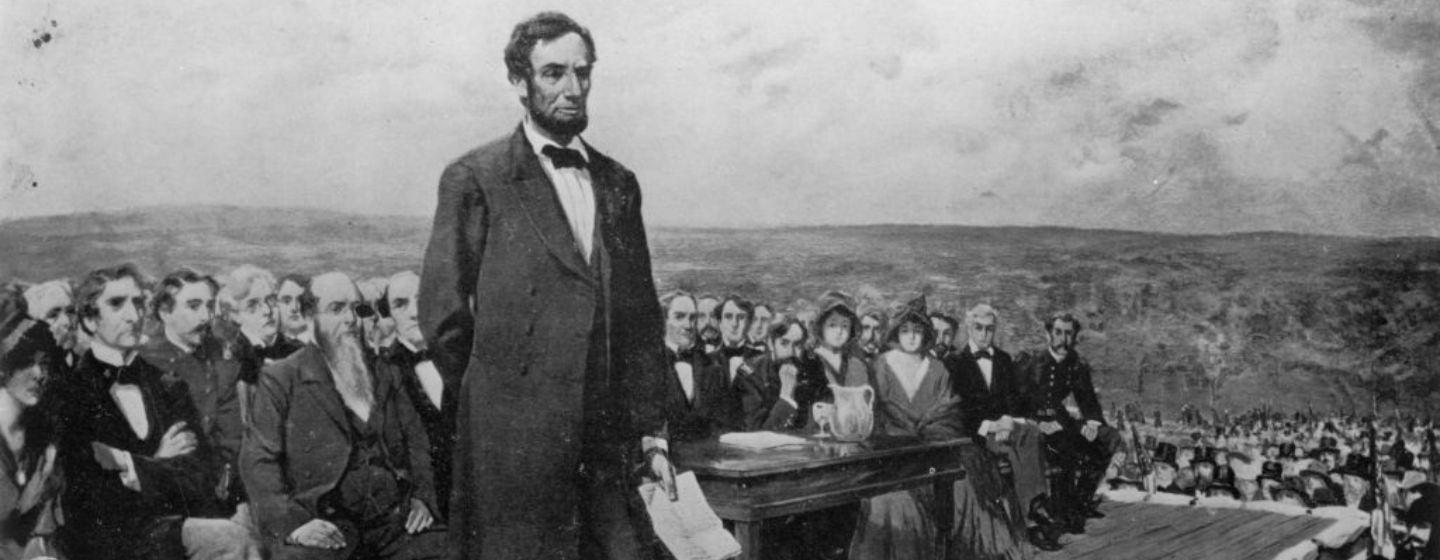Where Did Lincoln Stand During the Gettysburg Address?


Four score and 81 years ago on November 19, 1863, President Abraham Lincoln stood in a newly dedicated cemetery for Union soldiers killed at the Battle of Gettysburg and delivered one of the most stirring and famous speeches in American history.
The moment passed quickly. The Gettysburg Address is only 272 words and took about two minutes to deliver. In fact, Lincoln’s speech was so fast that photographers at the time were unable to capture the moment.
That has created a bit of a problem.
While scholars, politicians and history buffs focus on the meaning of the speech, the question most asked by visitors to the Gettysburg battlefield is where Lincoln stood when he delivered his address.
Various locations have been proposed over the years.
The Lincoln Address Memorial, a large monument dedicated in 1912, places the location inside Gettysburg National Cemetery, which Lincoln helped to dedicate in 1863. In 1995, another proposed location placed the speaker’s platform inside an adjacent cemetery, the private Evergreen Cemetery, which is the town’s burial ground. Today, a plaque in Gettysburg National Cemetery (also known as Soldiers’ National Cemetery) maintains a vague reference, saying the location “is believed to be in Evergreen Cemetery, on the other side of the iron fence.”
Now, Christopher Oakley, an associate professor of new media at UNC Asheville and a lifelong Civil War buff, is proposing a new location for the speaker’s platform and a modified location for where the speech was actually delivered.
Oakley’s research indicates that the speaker’s platform straddled both cemeteries, and that Lincoln delivered his speech well within the Gettysburg National Cemetery’s border.
“For the past four decades, scholarship has placed the speaker’s platform—and therefore Lincoln—entirely within Evergreen Cemetery,” Oakley shared in an interview on a Library of Congress blog. “My research reveals that the speaker’s platform straddled Evergreen and Soldiers’ National cemeteries and that Lincoln stood well within Soldiers’ National. So, for the first time in 40 years, Lincoln is back to where he was supposed to be—standing near the graves of the fallen soldiers.”
Oakley’s discovery came about as part of the Virtual Lincoln Project at UNC Asheville, an effort to create a photorealist digital animation of Lincoln delivering the Gettysburg Address.
Advanced students in the program learn Maya, one of the main programs used for digital animation. There’s a lot of research that goes into not only animating a primary subject but also placing it into a historically and culturally accurate setting.
“Our initial plan was to animate Lincoln delivering the address against a gray, neutral background,” Oakley told Sci NC. “But as the project progressed, we decided to put Lincoln in Gettysburg.”
In his quest for accuracy, Oakley discovered that more research about Lincoln’s precise location was needed.
“I told the students to keep working on the computer models while [I] did the research on the location and the shape and size of the speaker’s platform,” added Oakley. “I didn’t know it would add years to the project.”
There are six well-known photographs taken by three photographers from four different vantage points. They are all wide shots of the scene, but none depict the actual speech. The wide shots contain several landmarks: a flagpole, a poplar tree, a tent and the speaker’s platform, which is a tiny, blurry hump packed with people on the horizon.
By merging analysis of the photos with the computer graphics program Maya, Oakley was able to line up the landmarks, establish the precise locations of the cameras and triangulate the location of the platform.
Oakley says his research also discovered that the speaker’s platform was not a 12-by-20-foot rectangle as always believed but a much larger trapezoid.
“There were 39 people on the platform, and there’s no way they all could have fit on that small platform,” said Oakley. “I believe they were seated orchestra-style, in semicircular rows. And most important, the place where the speakers stood was on the National Cemetery side.”
In 2013, Oakley made headlines by claiming he had discovered a previously unknown image of Lincoln at Gettysburg in a photo taken by a well-known photographer at the time. The tiny, blurred profile image of a top-hatted man in a crowd is still debated by Civil War scholars and history buffs. More on that can be found in thisSci NC video from 2014:
This new discovery will be debated as well. But Oakley says he’s fine with that because what matters is the truth.
“Where he delivered the speech matters,” said Oakley. “Knowing you are standing on the spot fires up the imagination and transports you back to the time because this is hallowed ground. It gives you a better appreciation of history.”
Learn more about Lincoln in this article from the PBS series American Experience.